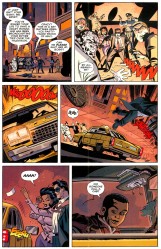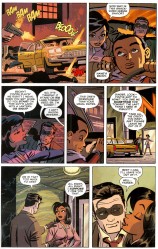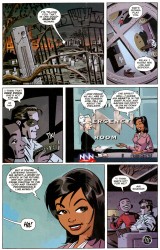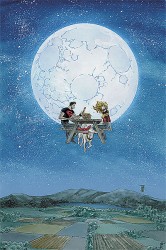Before The Hunter came out, Selina’s Big Score was my favorite Darwyn Cooke book. I’ve liked Catwoman for years, but for no good reason. It wasn’t the spandex, because I got over “ooh, hot girl comics!” pretty quickly. It definitely wasn’t the character, as I only really liked her in Miller and Mazzucchelli’s Year One before I read SBC.
I think what it was that made Selina’s Big Score work so much for me was the tone. SBC is this dark, inky, noir-y heist tale. There’s no costumes, not really. It’s just about a woman who needs a big score, the team she gathers to make it work, and the troubles she runs into. More than anything, though, it’s glamourous. The cover promises the kind of heist tale that features fast chases, pretty people, and action, like the finest of ’70s crime cinema.
The insides more than deliver. Characters are introduced by text on black panels, a technique I’ve always loved when I’ve seen it in movies. The graphic novel is divided up into four separate books, making for easy chapter and story breaks.
The first chapter, Selina, sets the stage for the book. Selina had money, but lost it, and now she needs it back. The second chapter, Stark, focuses on the muscle. The third chapter, Slam, gives us the down low on the man chasing Selina. The fourth chapter, Score, gives us the heist itself.
The writing is sharp and fast-paced. Old friends and new enemies are introduced with aplomb, leaving you just enough to get going, but not so much that you can’t apply a bit of imagination into the mix. Cooke doesn’t overload on the first person captions, either. Slam’s section is appropriately hardboiled, Stark’s is cynical and, well, stark, and Selina’s is borderline hopeful. Rather than being a crutch, or another way to show the tortured existence of these heroes as they buckle under several tons of angst, the captions come across as genuine character builders.
Selina’s Big Score crawls across genres, too. Slam’s the tired avenger, the very picture of the good man alone in a hard world. Stark is Parker– impatient, amoral, skilled at violence, and professional to a fault. Chantel is a blaxploitation figure, a good girl in a bad situation, and uses her sass as a defensive mechanism. Jeff is your ’90s action movie criminal, seemingly all flash and recklessness, but with a surprisingly solid core. And Selina? She’s the ever-present femme fatale, but put into a position where she’s the focus, rather than a sidekick or villain.
Cooke mines several decades of American cinema to create the comic book heist story to end all comic book heist stories. It gives Selina Kyle the Year One treatment. It redefines her for a new era, re-contextualizes her as a character, and provides a focus that I feel like wasn’t there before. Pre-SBC, to me, Catwoman was another sexpot in spandex, all cat puns and tortured Jim Balent poses, clothes strategically torn. After? She’s viable, interesting, and has a movie-ready story that puts a lot of other books to shame.





